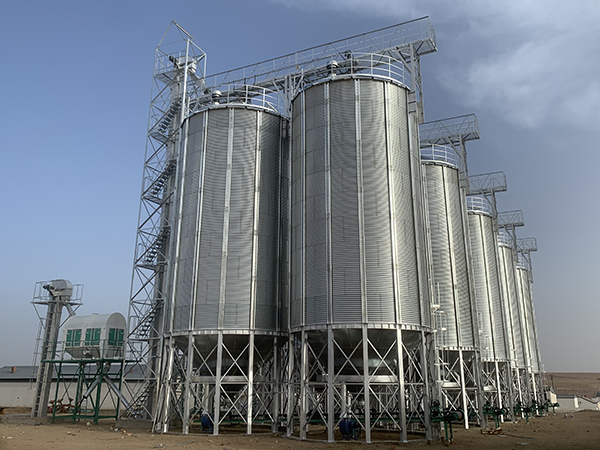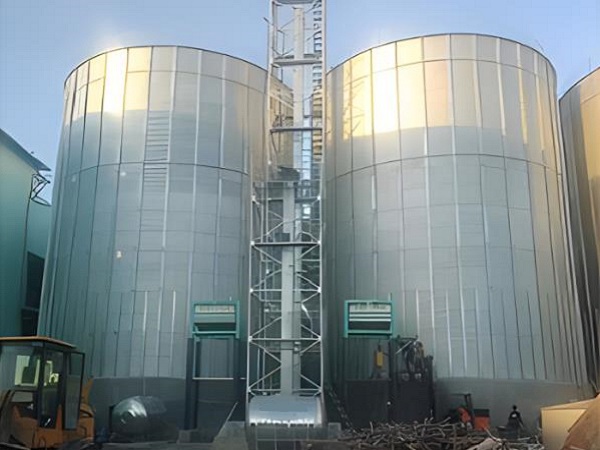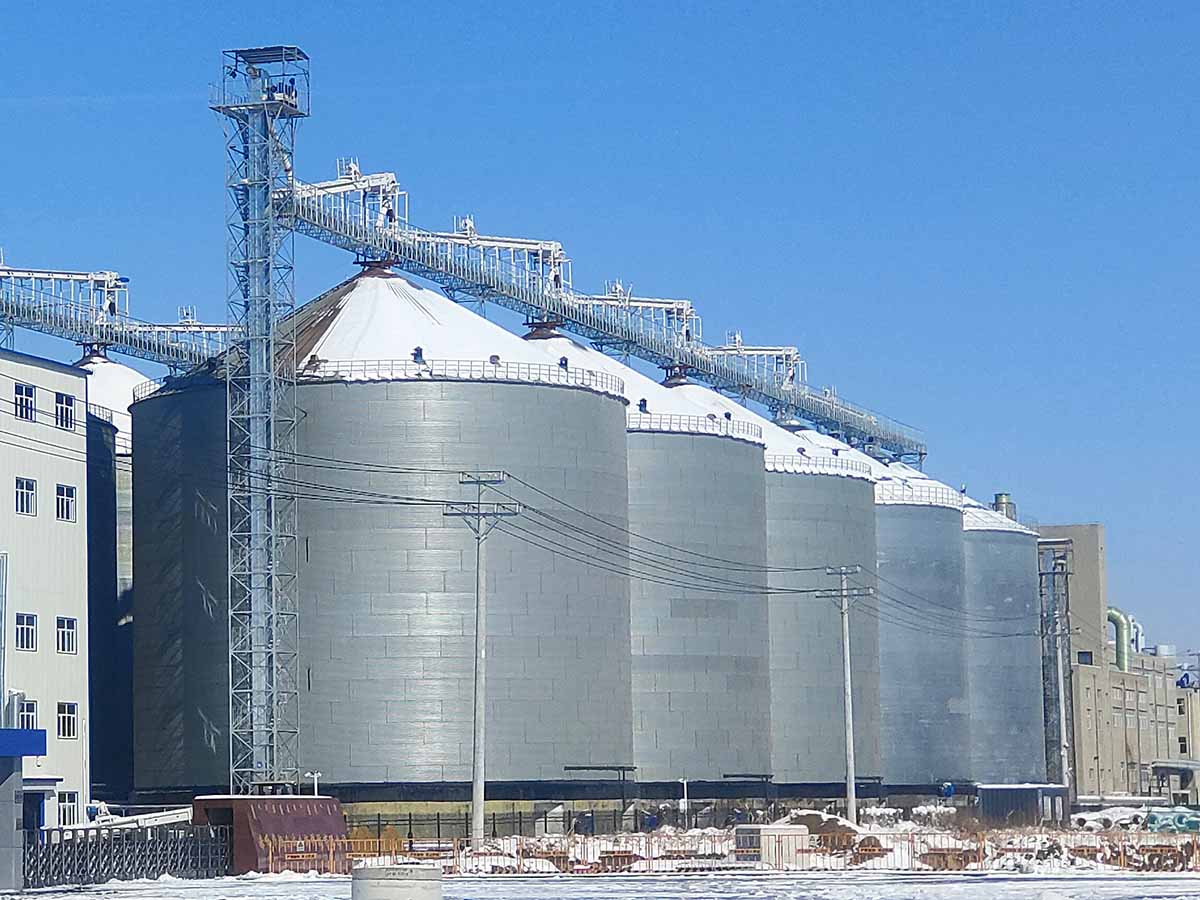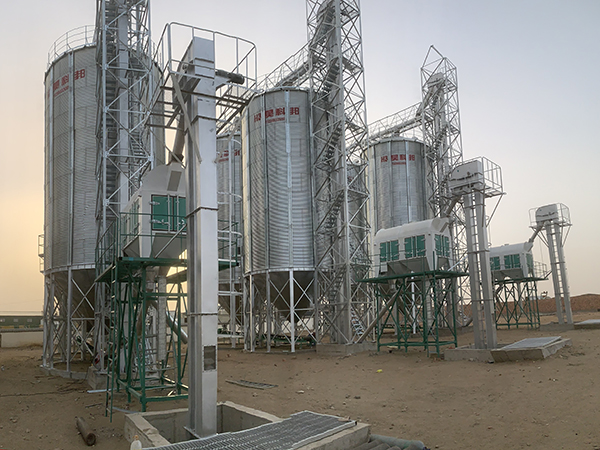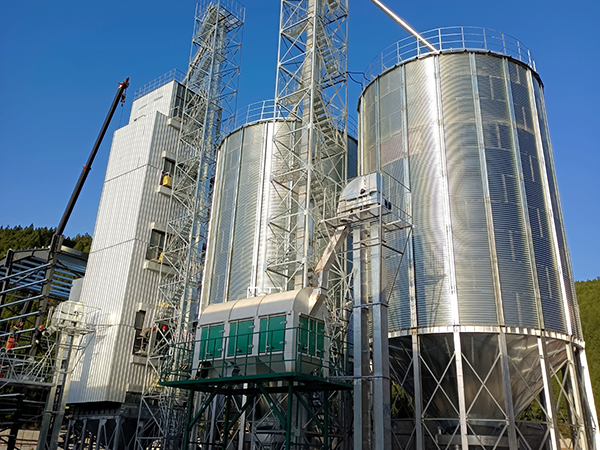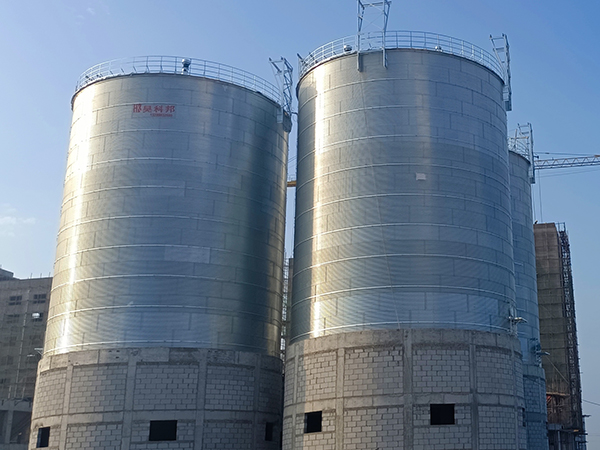Cereal silo
A cereal silo is a large container or structure specifically designed for storing grains, such as wheat, corn, soybeans, and other granular or powdered agricultural products.
Cereal silo Introduction
A cereal silo is a large container or structure specifically designed for storing grains, such as wheat, corn, soybeans, and other granular or powdered agricultural products. These silos are typically made of metal, such as steel or aluminum, or concrete, and are designed in cylindrical or rectangular shapes to maximize storage space while protecting the stored grain from external environmental factors, such as humidity, pests, and microorganisms.

Cereal silo Features
Durability
cereal silo are typically constructed from durable materials such as steel, aluminum, or concrete, which can withstand various weather conditions and environmental impacts, ensuring the long-term stability of the silo.
Large Capacity
The capacity of silos ranges from several thousand tons to hundreds of thousands of tons, making them suitable for large-scale centralized storage, which facilitates the turnover of bulk grains in agricultural production and trade.
Protective Design
The design of silos takes into account the need to protect the stored grain from humidity, pests, microorganisms, and rodents. They are usually equipped with sealed doors and ventilation systems to control the internal environment.
Automated Operation
Modern cereal silo are often equipped with advanced automation equipment, such as feeding systems at the top of the silo (including unloading hoppers, conveyor belts, cleaning equipment, etc.), discharge systems at the bottom (including pneumatic conveying, screw conveyors, or gravity discharge, etc.), and sensors to monitor the temperature, humidity, and pressure of the grain, achieving efficient and precise grain storage management.
Supporting Facilities
Around the silos, there are usually supporting facilities such as grain drying equipment, cleaning equipment, weighing equipment, and transportation connection facilities (such as railway spurs, truck loading and unloading areas, etc.), forming a complete system for grain reception, storage, processing, and logistics.
Grain Storage Safety
cereal silo may be equipped with ventilation systems to adjust the temperature and humidity inside the silo through forced or natural ventilation, preventing the grain from heating and molding. Some silos are also equipped with fumigation equipment for pest control. In addition, the silos should comply with fire regulations and have necessary fire prevention and explosion-proof facilities.
Grain Monitoring
Modern silos are equipped with grain monitoring and control systems that utilize multiple thermocouple cables or wireless sensors installed within the silo to monitor the temperature distribution of the grain in real time. This allows for the early detection and management of issues such as heat damage and mold. Some systems are also capable of monitoring parameters like humidity and oxygen levels, providing data support for the scientific storage of grain.
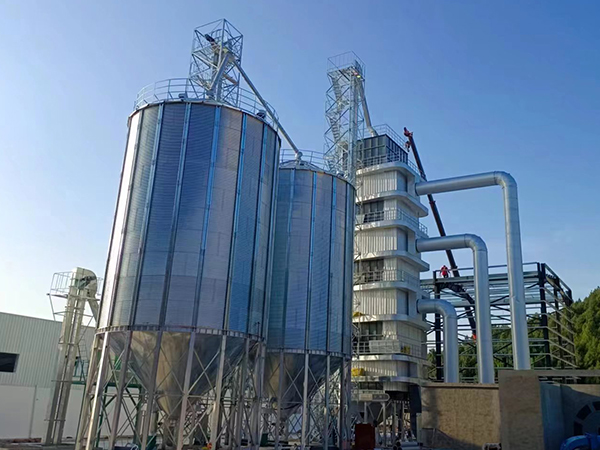
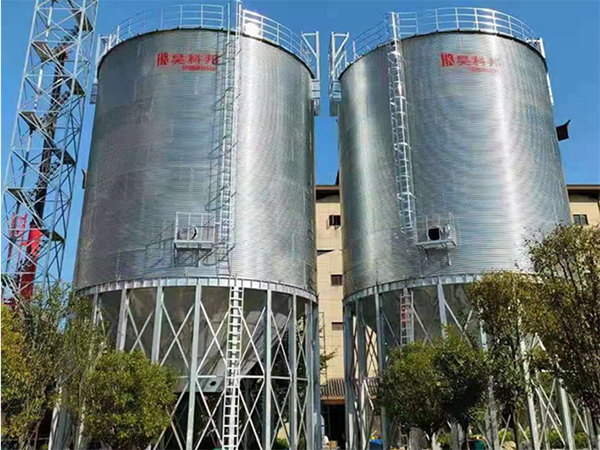
Cereal silo Structure
Foundation
This is the base of the silo structure that supports the weight of the entire silo and transfers it to the ground. The design of the foundation takes into account factors such as soil type, groundwater level, and load-bearing capacity.
Silo Body
The silo body is the main part of the silo, typically made of metal sheets (such as steel plates) or concrete. The design of the silo body must ensure sufficient strength and rigidity to withstand the weight of the grain inside and the effects of the external environment.
Roof Structure
The roof structure of the silo can be flat, domed, or of other shapes, designed to protect the interior of the silo from weather elements such as rain and wind. The roof structure needs to have good waterproof and sealing properties.
Discharge System
This system is used to remove grain from the silo and may include a conical bottom, screw conveyor, pneumatic conveying system, or other mechanical discharge devices.
Feed System
The feed system is used to load grain into the silo and may include conveyor belts, bucket elevators, scraper conveyors, and other equipment.
Ventilation System
To control the internal temperature and humidity of the silo and prevent grain spoilage, the ventilation system regulates the internal environment by providing air circulation.
Inspection Doors and Maintenance Hatches
These are openings used for inspecting the interior conditions of the silo, performing maintenance, and cleaning. They are typically equipped with sealed doors to maintain the airtightness of the silo.
Safety Equipment
This includes fire-fighting equipment, explosion-proof devices, ventilation control systems, etc., ensuring the safety of silo operations.
Monitoring and Control System
Modern silos may be equipped with automated monitoring and control systems that monitor environmental parameters inside the silo in real-time, such as temperature and humidity, and make corresponding adjustments.
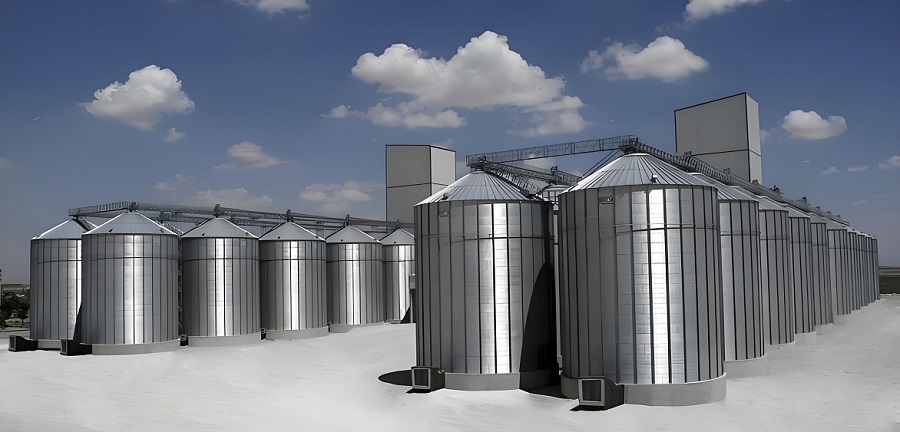
Cereal silo Advantages
Efficient Storage Capacity
cereal silo are designed to store large quantities of grain, meeting the needs of large-scale agricultural production and commerce, thereby enhancing the efficiency of grain storage.
Long-term Preservation
By controlling the environmental conditions within the silo, such as temperature and humidity, cereal silo help maintain the freshness and quality of the grain, extending its storage life.
Protection from Pests and Contamination
The sealed nature of silos effectively prevents the intrusion of pests and microorganisms, reducing the risk of grain contamination from external sources.
Reduced Losses
Compared to traditional open storage, cereal silo can significantly reduce grain losses due to weather, animals, and human factors.
Convenience in Operation
Modern cereal silo are often equipped with automated loading and unloading systems, making the operation of grain storage and retrieval more convenient and efficient.
Space-saving
The vertical design of silos means they occupy relatively little land area, helping to conserve valuable land resources, especially in areas where land costs are high.
Ease of Monitoring and Management
With the installation of monitoring systems and sensors, the condition of the grain within the silo can be tracked in real-time, allowing for the prompt identification and resolution of issues.
Environmental Friendliness
The design and operation of cereal silo can minimize environmental impact, such as reducing the demand for natural resources by decreasing grain loss.
Flexibility and Adaptability
The design of cereal silo allows for the storage of various types of grain crops, providing good adaptability and the ability to respond to market changes and diverse storage needs.
Safety
The structural design and safety features of silos, such as fire prevention and explosion protection systems, ensure the safety of the grain storage process.
Application scope of Cereal Silo
Coban Silo is widely used for grain storage such as wheat, corn, soybean, paddy, rice, soybean meal, barley, malt, sunflower seeds, rapeseed, peanuts, flour, and other powder materials, oat, special Silo, and seeds, etc.
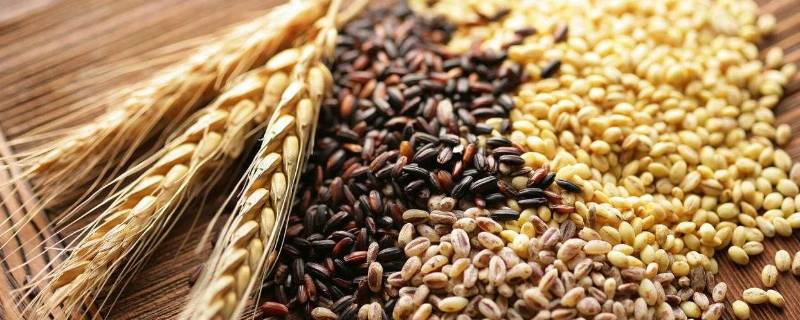
Cereal Silo technical parameters
Scientifically speaking, the Silo capacity should be measured with volume (m3). Even in the same grain Silo, the storage tons will be different for different grains with different densities. The following table is calculated based on a Silo density of 0.75kg/m3, and surely HKB customizes Silo systems unique for you.
| Most Popular Hopper Bottom Steel Silo Technical Specifications | ||||||||
| Capacity | 50Ton | 100Ton | 150Ton | 200Ton | 300Ton | 500Ton | 1000Ton | 1500Ton |
| Model | TCZK
03605 |
TCZK
04507 |
TCZK
05507 |
TCZK
06406 |
TCZK
07307 |
TCZK
07313 |
TCZK
11010 |
TCZK
12811 |
| Diameter(m) | 3.667 | 4.584 | 5.500 | 6.417 | 7.334 | 7.334 | 11.000 | 12.834 |
| Total Height(m) | 9.56 | 12.53 | 13.25 | 12.85 | 14.70 | 21.42 | 20.95 | 23.51 |
| Volume(m³)
Density:0.75ton/m³ |
69 | 150 | 222 | 273 | 415 | 699 | 1346 | 2039 |
| Most Popular Flat Bottom Steel Silo Technical Specifications | ||||||||
| Capacity | 1000Ton | 1500Ton | 2000Ton | 2500Ton | 3000Ton | 5000Ton | 8000Ton | 10000Ton |
| Model | TCK
10014 |
TCK
11915 |
TCK
13715 |
TCK
15514 |
TCK
15518 |
TCK
18321 |
TCK
24718 |
TCK
25621 |
| Diameter(m) | 10.084 | 11.918 | 13.750 | 15.584 | 15.584 | 18.334 | 24.751 | 25.668 |
| Total Height(m) | 18.69 | 20.34 | 20.87 | 20.30 | 24.78 | 28.60 | 26.99 | 30.60 |
| Volume(m³)
Density: 0.75ton/m³ |
1335 | 2009 | 2701 | 2467 | 4145 | 6693 | 10879 | 13484 |
After-sale Service
- – HKB provides advanced grain safety storage technology to assure your grain silo 100% quality stability.
- – grain silo Quality guarantee is one year after installation and commissioning or 18 months after leaving China Port. Maturity is the first.
- – 7 days x 24 hours service, within 24 hours reply/solve of any technical issues upon request.
- – Routinely telephone track to remove all might be problems grain silo or issues guarantying the whole system grain silo long-lasting safety and reliability.
- – HKB will consider all other needs like customs clearance, sea delivery, insurance, customs tax benefit plan, documentation, etc. So our respected Users feel so relaxed and easy to get the grain silo system well.

